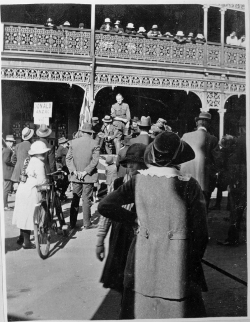Here’s one for Valentine’s Day. This is an image from one of the (North) coastal photographic collections held at the University of New England and Regional Archives .
Tag Archives: University of New England and Regional Archives
Frosty Headstones (It’s better than OCR!)
A particularly chilly night set a thick frost across the region. Ice crystals form on solid surfaces like cars and footpaths. Our hardy researcher walked out to see the sights and happened past some rural graves with engraved sandstone slabs
From Uralla 1916 to Europe 2010 – Anzac Commemorations & New England
In 2010 there are very few Australians alive that can remember back to the first commemoration of ANZAC Day in 1916……
Old State – New States: New England and the New State Movement
The residents of rural New South Wales have for generations maintained an uneasy relationship with the capital city. A long standing joke in the bush was that the initials N.S.W. stood for Newcastle, Sydney and Wollongong.
“This is all very silly” : An interesting start to a regional archives
Only a few years previously during World War Two, Armidale was the chosen location for storing material held by the Mitchell Library. To argue within five years that the same locality could not be trusted to manage government records inflamed local sensitivities.
New England remembers through the archives: World War I
…….look closely at the walking sticks, stiff poses and empty sleeves. Captured here is a reminder of the immense impact of World War One on young Australians.
Land record found! A stray returns from the “Land of the Beardies”
It is an interesting fact that many frontier locations like Wellingrove, lost population and government services as circumstances changed over time. Government records from this period sometimes strayed from official custody and some remain undiscovered to this day.
Using shadows to date photographs (part 2)
The exact location of the photo is critical to the process. Without knowing your location on the planet, you cannot work out the location of the sun to get the date and time.
Using shadows to date photographs
This is a guest post from William Oates, University Archivist, Heritage Centre University of New England.
The team at the University of New England (UNE) and Regional Archives has been trialling dating some of the photographs in their collection using the shadows cast by the sun. The two photos in this post are from a series of 29 photograph albums created by the White sisters of ‘Saumarez’ Homestead near Armidale. Donated by the family to the regional archives at UNE, these images capture aspects of the late Victorian and Edwardian rural lifestyle enjoyed by the White family.
The photographs in question portray scenes from a recruitment rally in the streets of Armidale during World War One. One precise method for dating of the event could have been obtained by reviewing newspaper articles during the war years. Instead, dating methodology using the shadows cast by the sun on a given map reference was tested by a volunteer at the UNE & Regional Archives.
The location of the photo was easily identified from the hotel in the background. A shadow of identifiable length was found in one picture and from this a number of possible dates generated from the available algorithm. Once this date was calculated, we then searched the newspapers to locate the story.
On the 11th August 1917, a recruiting team for the Australian Imperial Forces was invited to a series of functions in Armidale according to the Armidale Chronicle. This team included Victoria Cross winner Billy Jackson who lost his hand in action in France in 1916. The moment captured by one of the White girls clearly shows the recruiting team with Jackson in attendance.
Using shadows to date photographs (part 2)
William Oates
(Photographs courtesy of: University of New England and Regional Archives – (A1473) White Family Photographs – Album 4. Please contact for further information)


